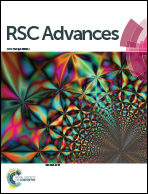Facile non-injection synthesis of high quality CZTS nanocrystals†
Abstract
We present a facile, non-injection synthesis of high quality CZTS nanocrystals by using simple inorganic salts, sulfur powders and (CH3)3COK (KTB) as precursors. The uniqueness and creativity is the utilization of KTB as sulfur activating agent and stabilizing surfactant agent.


 Please wait while we load your content...
Please wait while we load your content...